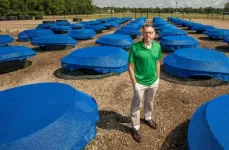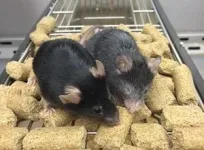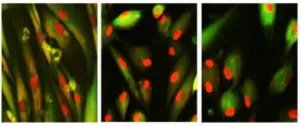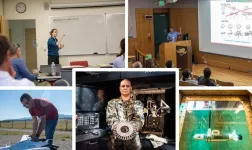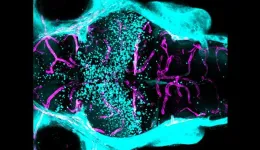(Press-News.org) Schistosomiasis, a parasitic disease that causes organ damage and death, affected more than 250 million people worldwide in 2021, according to the World Health Organization.
One of the world’s most burdensome neglected tropical diseases, schistosomiasis occurs when worms are transmitted from freshwater snails to humans. The snails thrive in water with plants and algae that proliferate in areas of agricultural runoff containing fertilizer. People become infected during routine activities in infested water.
Researchers from the University of Notre Dame, in a study recently published in Nature, found that removing invasive vegetation at water access points in and around several Senegalese villages reduced rates of schistosomiasis by almost a third. As a bonus, the removed vegetation can also be used for compost and livestock feed.
“Disease, food, energy, water, sustainability and poverty challenges intersect in many ways, but are typically addressed independently,” said lead author Jason Rohr, the Ludmilla F., Stephen J. and Robert T. Galla College Professor and Department Chair in the Department of Biological Sciences at the University of Notre Dame. “We sought to break down these silos and identify win-win solutions, while demonstrating their cost effectiveness so that residents would hopefully adopt them widely.”
Rohr and his team spent seven years on the project, with research conducted in 23 villages and clinical trials in 16. They found that villages with substantial fertilizer use had more submerged vegetation. These villages had more snails and a higher prevalence of schistosomiasis infection in children, said Rohr, who is affiliated with the Notre Dame Environmental Change Initiative and the Eck Institute for Global Health.
Researchers hypothesized that removing vegetation could reduce infections while providing greater access to the open water that is crucial for daily activities and recreation. So, they conducted a three-year randomized controlled trial in 16 communities, where children were treated for their infections and the researchers removed more than 400 metric tons of vegetation in water access points from half the villages. These removals resulted in a decline in snail abundance as well as schistosomiasis infection rates being nearly a third lower than those observed in control villages.
Rohr’s team also tried to profitably improve food production by partly closing the nutrient loop, returning nutrients captured in the removed plants back to agriculture. So, they worked with local farmers to compost the vegetation for use on pepper and onion plants, increasing their yields, and demonstrated that the vegetation could be effectively used as cattle, sheep and donkey feed. Alexandra “Lexi” Sack, who worked as a postdoctoral researcher in Rohr’s lab from 2021 to 2023, assisted Senegal’s in-country team with the care and design of the sheep-feeding trials, and performed much of the analysis of the vegetation removal results.
“This is important work because it encompasses many different disciplines by combining schistosomiasis prevention and food security,” Sack said. “Often these interventions are separate when the neglected tropical diseases, which includes schistosomiasis, are contributing both to and resulting from poverty.”
With the expertise of co-authors Christopher B. Barrett, an economist at Cornell University, and Molly Doruska, a doctoral student also at Cornell, the research team demonstrated that the benefits of removing the vegetation and using it in agriculture were nearly nine times higher than the costs.
“We took this public nuisance, which is reducing health, and converted it into a private good that improves income,” Rohr said.
The team was also able to illustrate how to scale the project using artificial intelligence and satellite imagery to identify snail habitat and thus hotspots for schistosomiasis, which will allow them to target their intervention training to areas that need it the most.
Villagers helped with removing vegetation once they understood the public health benefits of the intervention, but in the long run, relying on voluntary labor may not be as effective as the researchers removing the vegetation.
“In the next steps, sociologists and economists on the project will quantify how the innovation affects quality of life and whether it is biased based on wealth, gender and/or age,” Rohr said.
The team will also investigate how biodigesters might be implemented to turn the aquatic vegetation into fertilizer and gas that can be used for cooking or to fuel generators for electricity production. Rohr said they hope to leverage investments by the Swiss government, which has committed to installing 60,000 biodigesters in Senegal for carbon credits.
The ongoing research could not be accomplished without all of the partners who contributed, especially the Senegalese citizens, Rohr said.
Christopher Haggerty, a postdoctoral student at Notre Dame during the study, contributed to this research. A complete list of co-authors can be found on the paper at Nature.
The research was funded by the National Institutes of Health, the National Science Foundation, the Indiana Clinical and Translational Sciences Institute and a Stanford seed grant.
END
Eliminating public health scourge can also benefit agriculture
2023-07-12
ELSE PRESS RELEASES FROM THIS DATE:
Rosé renaissance: Spanish study uncorks ultrasound for superior wine quality
2023-07-12
Since the International Organisation of Vine and Wine (OIV) approved the use of ultrasound to promote the extraction of grape compounds back in 2019, its application for obtaining superior red wines has been studied extensively.
Now researchers are turning their attention to rosé – an expanding market which has seen strong growth over the past 15 years. A team from the University of Castilla-La Mancha and the University of Murcia in Spain used high-power ultrasound technology to treat Monastrell crushed grapes – a process known as sonication ...
NEW STUDY: Discovery of chemical means to reverse aging and restore cellular function
2023-07-12
On July 12, 2023, a new research paper was published in Aging, titled, “Chemically induced reprogramming to reverse cellular aging.”
BUFFALO, NY- July 12, 2023 – In a groundbreaking study, researchers have unlocked a new frontier in the fight against aging and age-related diseases. The study, conducted by a team of scientists at Harvard Medical School, has published the first chemical approach to reprogram cells to a younger state. Previously, this was only achievable using a powerful gene ...
Empowering student ideas: NPS introduces the Naval Innovation Exchange
2023-07-12
The Naval Innovation Center (NIC) at the Naval Postgraduate School (NPS) in Monterey, Calif., is part of the Secretary of the Navy’s initiative to leverage the power of American innovation for national security. Integral to the function of the NIC is the Naval Innovation Exchange (NIX), a new program that organizes and empowers multidisciplinary teams of NPS students and faculty focused on developing prototype research solutions.
While in its early stages, the NIC at NPS will leverage and empower ...
Researchers uncover signal needed for blood-brain barrier
2023-07-12
At a glance:
Working with mice and zebrafish, researchers identify a gene, expressed in neurons, that produces a signal needed for development and maintenance of the blood-brain barrier.
When mutated, the gene makes certain regions of the blood-brain barrier more permeable.
The findings could help scientists control the blood-brain barrier — important for delivering drugs into the central nervous system or countering damage from neurodegenerative disease
What makes the vital layer of protective cells around the brain and spinal cord — ...
Psychedelic-assisted therapies for patients with PTSD
2023-07-12
Psychedelic-based therapies are poised to change the treatments that psychiatrists can offer patients.
“I often talk about psychedelic treatments as catalysts for change, for both the individual and the field of psychiatry,” said Medical University of South Carolina psychiatrist Jennifer Jones, M.D., who conducts research on these treatments.
The highly anticipated approval of MDMA, or “ecstasy,” to treat post-traumatic stress disorder would be the first for a psychedelic drug, ushering in changes for patients, mental health providers and society. The Food and Drug Administration is expected to issue a decision on MDMA-assisted ...
Mass General Cancer Center researchers pinpoint protein tied to drug resistance in patients with lung cancer
2023-07-12
Cancer therapies that target specific genetic abnormalities in tumors have revolutionized treatment possibilities over the past two decades. While quality of life and survival are improved with targeted therapies, relapse is common due to the evolution of new tumor cells that are resistant to the targeted therapy. A new study by investigators from the Mass General Cancer Center, a member of the Mass General Brigham healthcare system, reveals how lung tumors may develop drug resistance over time, pointing to a protein, called APOBEC3A, that could be a promising target. Results, published in Nature, may help researchers develop new ...
Could drops replace eye injections for retina disease?
2023-07-12
NEW YORK, NY-- A new study suggests that eye drops developed by Columbia University researchers could be a more effective–and comfortable–therapy for a common eye disease currently treated with injections into the eye.
Retinal vein occlusion (RVO), an eye disease that affects up to 2% of people over age 40, occurs when a vein in the eye’s retina becomes blocked, leading to swelling in the eye, inflammation, damage to the retina, and vision loss.
Standard therapy involves injecting into the eye a vascular endothelial growth factor inhibitor (anti-VEGF) that reduces swelling. ...
New radar technique lets scientists probe invisible ice sheet region on Earth and icy worlds
2023-07-12
Scientists at the University of Texas Institute for Geophysics (UTIG) have developed a radar technique that lets them image hidden features within the upper few feet of ice sheets. The researchers behind the technique said that it can be used to investigate melting glaciers on Earth as well as detect potentially habitable environments on Jupiter’s moon Europa.
The near-surface layers of ice sheets are difficult to study with airborne or satellite ice-penetrating radar because much of what’s scientifically important happens too close to the surface to be accurately imaged. ...
How the immune system can alter our behavior
2023-07-12
New Haven, Conn. — Simply the smell of seafood can make those with an allergy to it violently ill — and therefore more likely to avoid it. The same avoidance behavior is exhibited by people who develop food poisoning after eating a certain meal.
Scientists have long known that the immune system played a key role in our reactions to allergens and pathogens in the environment, but it was unclear whether it played any role in prompting these types of behaviors towards allergic triggers.
According to Yale-led research published July ...
Warmer ocean temperatures increase risk of salmon bycatch in Pacific hake fishery
2023-07-12
NEWPORT, Ore. – Rates of Chinook salmon bycatch in the Pacific hake fishery rise during years when ocean temperatures are warmer, a signal that climate change and increased frequency of marine heatwaves could lead to higher bycatch rates, new research indicates.
During years when sea surface temperatures were higher, including during a marine heatwave, Chinook salmon were more likely to overlap with the Pacific hake and raise the risk of bycatch as they sought refuge from higher temperatures.
The findings, based on ...
